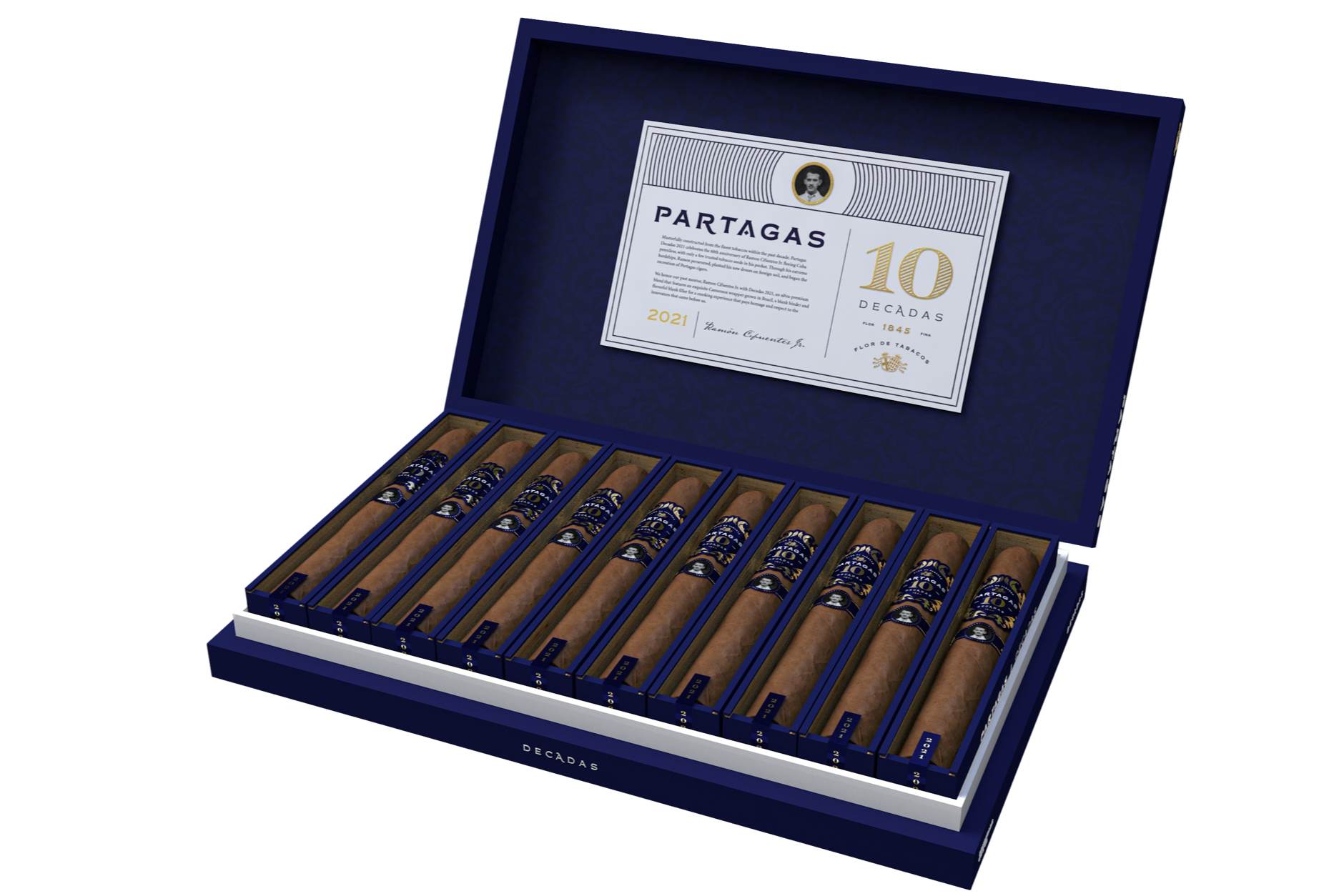In 2019, General Cigar Co. brought back its Partagas Decadas line for a limited release. While the company released the Decadas from 2005-2009, it went on hiatus for more than a decade. Oddly, that’s not what the Decadas part of the name refers to, instead, that’s a reference to the age of the wrapper, as it’s 10-years-old.
Or at least that’s what it was referencing. The 2021 version of the Partagas Decadas is very much about a unique wrapper, though it’s not due to how old the wrapper is, instead where it comes from. Over the years, the Partagas Decadas has used Cameroon wrappers for most, if not all of its releases, and the 2021 edition sort of continues the trend. Instead of using tobacco from the country of Cameroon, it uses Cameroon-seed tobaccos grown in Bahia, Brazil. Underneath it is a Connecticut habano binder and a variety of fillers including Dominican piloto and tobaccos from three of Nicaragua’s growing regions: Estelí, Jalapa and Ometepe.
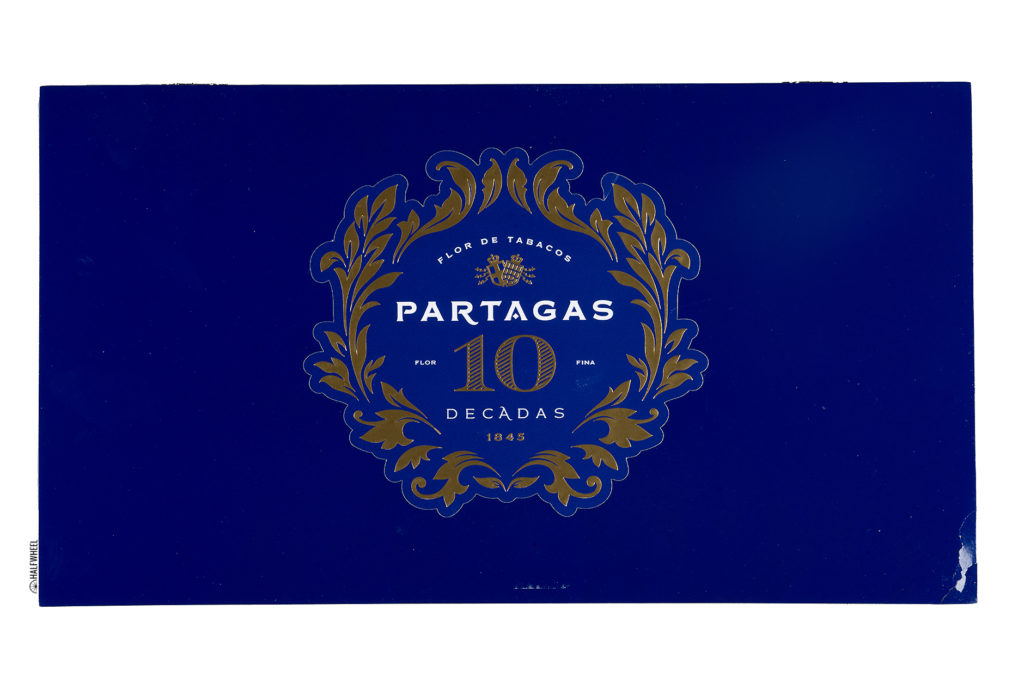
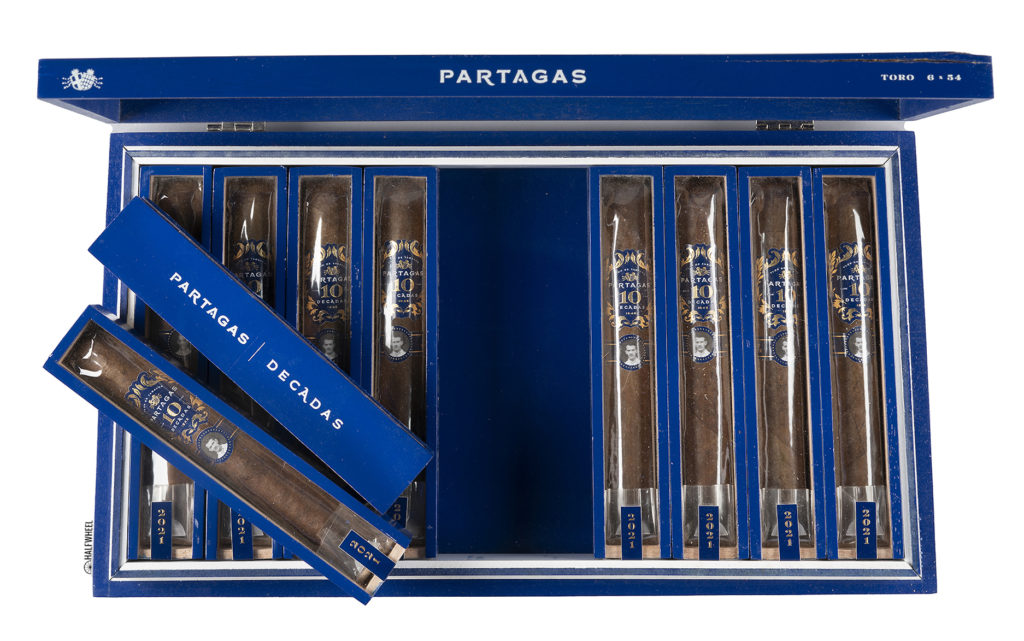
I can’t think of another cigar that uses Cameroon-seed tobacco from Brazil and it’s quite likely this is the first time I’m smoking a production cigar using this wrapper. Of note, Forged Cigar Co.—a sister company to General Cigar Co. that handles the sales of Partagas in the U.S.—did not disclose the age of the wrapper.
The Partagas Decadas 2021 is offered in a single 6 x 52 toro size that comes packed in blue coffins. Forged did not disclose production numbers.
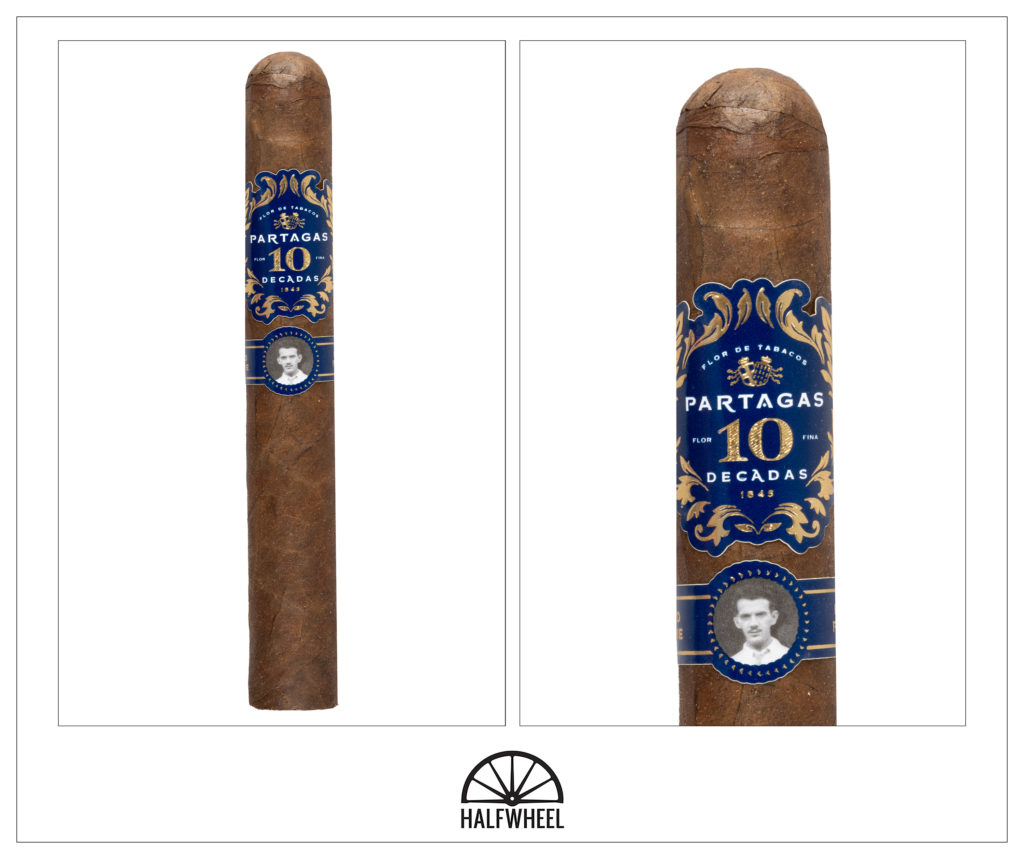
- Cigar Reviewed: Partagas Decadas 2021
- Country of Origin: Dominican Republic
- Factory: General Cigar Dominicana
- Wrapper: Brazil (Cameroon Seed)
- Binder: U.S.A. (Connecticut Habano)
- Filler: Dominican Republic (Piloto) & Nicaragua (Estelí, Jalapa & Ometepe)
- Length: 6 Inches
- Ring Gauge: 52
- Vitola: Toro
- MSRP: $17.99 (Box of 10, $178.90)
- Release Date: November 2021
- Number of Cigars Released: Undisclosed
- Number of Cigars Smoked For Review: 3
As someone that owns an Audi in Sepang Blue, I’m a big fan of this shade of blue, even if it doesn’t match my car. It’s bright, it’s vibrant and it’s nearly impossible to look over. Unfortunately, there was some damage to the box—more on that below. I’d also point out that the inside of the box smells. If I had to guess, this is the result of the painted coffins sitting inside a closed environment. Fortunately, the inside of the coffins don’t smell and I’m unable to detect any of the paint smells on the cigar itself. I wouldn’t say I have any strong feelings about cigar companies using coffins, but there are three noticeable downsides: 1. using coffins costs more money than not, 2. they end up being pretty wasteful since that aren’t that many things you could reuse a cigar coffin for, 3. you can’t see what the cigar looks like. General Cigar Co.—err, Forged Cigar Co.—tried to resolve the latter issue by using a piece of acrylic as the top part of the coffin. And while you can see the cigar, between the coffin and the cellophane, it’s really tough to get a sense of what it actually looks like. Once the plastics—both coffin top and cellophane—have been discarded, I see a wrapper that is darker and more vibrant than most Cameroon wrappers, almost looking like a corojo wrapper. The aroma from the wrapper is medium with scents of macadamia nuts, fish sauce, saltiness and a bit of a plastic smell. Smelling the foot reveals a stronger aroma, which includes a mixture of raisins, brown sugar and some fresh-cut grass. That brown sugar carries over to the cold draw, joined by a weird, artificial chocolate flavor, some earthiness, roasted flavors and touches of lime and white pepper.
It seems like just about every cigar I am assigned to review of late is struggling to produce enough smoke on the first puff, and that continues with the Partagas. Flavor-wise, there’s some charred earthiness and a bit of brown butter. It’s medium-plus and I’m guessing that there are more flavors to be tasted, though that’s not apparent upon the first puff. Eventually, those other flavors emerge and the profile settles on a semi-sweet earthy core with some black pepper. Behind it are varying amounts of cognac-like flavors, oak and some chalkiness. What’s particularly odd is that the main flavors are hitting just the tip of my tongue and I’m unable to detect flavors on the other parts of my tongue. It finishes with an acidic berry flavor—almost like a red wine—some drier herbal, chalkiness, milder amounts of black pepper and liquid smoke at the very end. Retrohales have great umami sensations along with raspberry, earthiness, kiwi and a concentrated white pepper. Like the rest of the profile, the retrohale’s finish can get a bit too dry for my liking thanks to earthiness, some dry pasta, tartness and a deep white pepper. Flavor is full, body is medium-full and strength is medium. Construction is okay on two cigars, but the first Partagas Decadas I smoke is needing constant relights. Also, two of the three cigars experience some pretty strange cracking. Smoke production fixes itself and so long as the cigar is burning properly, I can get plenty of smoke in my mouth.
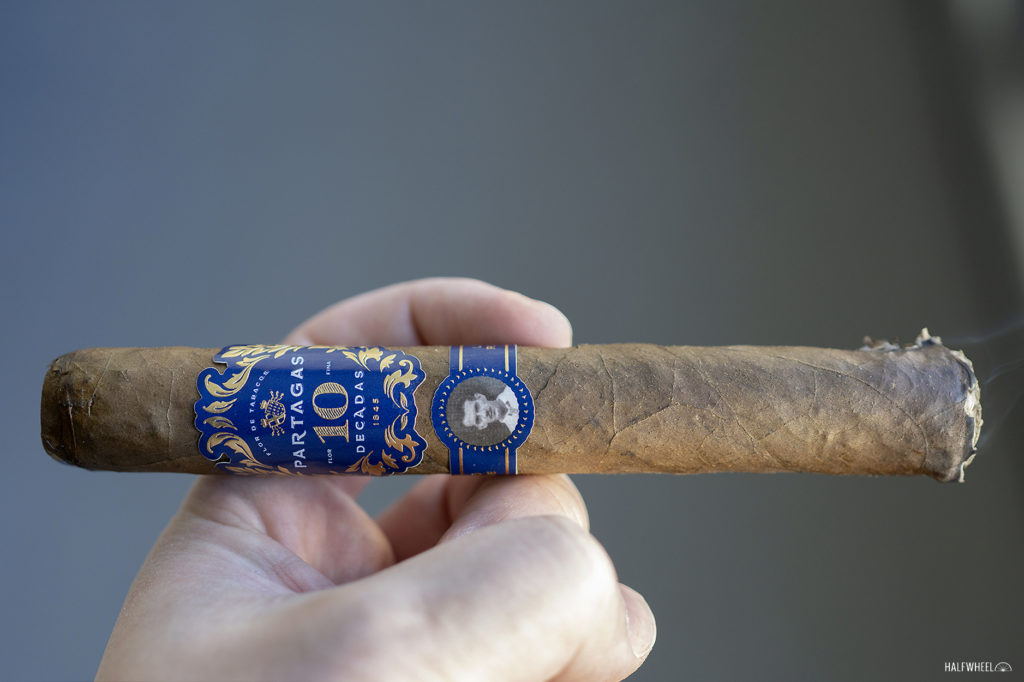
While the earthiness sticks around to lead the Partagas Decadas’ profile in the second third, the rest of the flavors have changed. Behind the earthiness are bread, herbal flavors, a buttermilk creaminess and small touches of sugar. It finishes quite toasty with charred earth, black pepper and white pepper joining the mixture. It’s not as dry as before, but the pepper and herbal flavors aren’t my favorites given the level of dryness. Retrohaling leads to sensations of black pepper, sourdough bread and white pepper. Once again, like the main flavor in the first third, there are times when this Partagas is only able to deliver flavors into specific parts of my palate and that’s what’s happening during the retrohale of the second third. The finish has white pepper, dry crackers and some saltiness. Flavor is medium-full to full depending on the cigar, body is medium-plus and strength is medium-plus. Construction on one cigar remains great, one cigar needs a touch-up and the cigar that had problems in the first third continues to have problems.
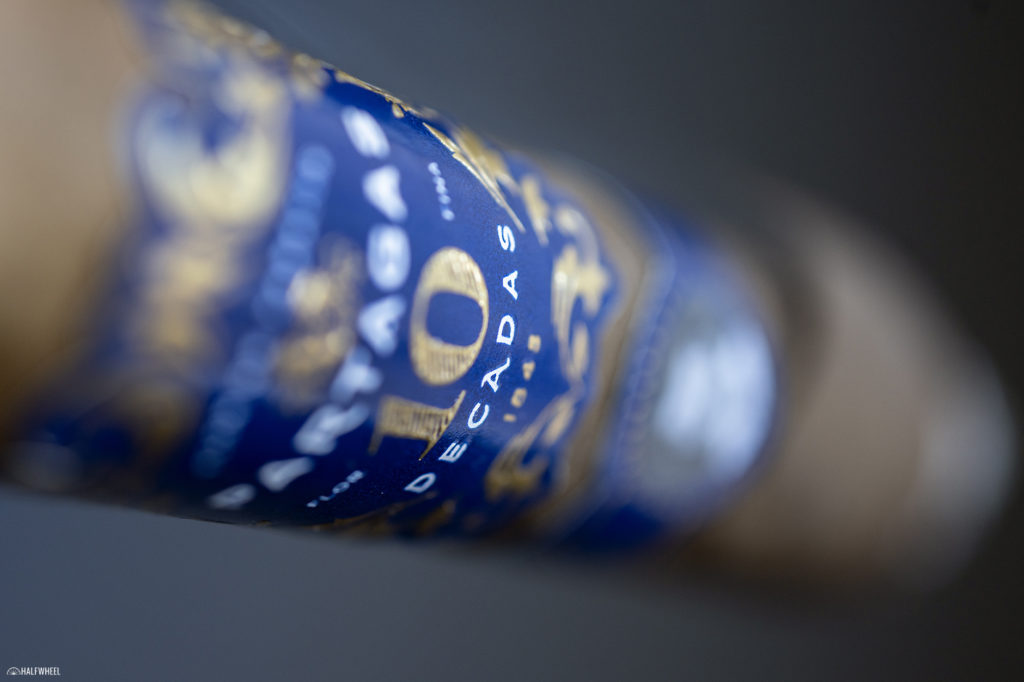
Earthiness continues to be the leading flavor for the Partagas Decadas, now accented by dry crackers, saltiness, white pepper and leather. I don’t think the earthiness gets any stronger in the final third, but the secondary flavors are further apart than before. The finish starts with bread flavors and then turns earthy. Eventually, it gets crispier as flavors like peanut shells emerge. There’s no pepper for about 10 seconds, and then some white pepper kicks in. Retrohales have flavors of soy sauce, earthiness, a bit of creaminess and lemon. Some puffs have white pepper, but there are other times when I push smoke through my nose and find zero pepper. The finish has some rocky mineral flavors over dry herbs and black pepper. With an inch or so left, the dryness picks up a lot and the cigars get borderline metallic, a good sign that it’s time for me to stop. Flavor is medium-full, body is medium-plus and strength is medium-plus. Touch-ups are needed on all three cigars, though otherwise, construction is fine.

Final Notes
- These cigars were smoked during the end of January and late February due to a number of reasons, while the review is being published now, at the end of the month.

- While I like the look of the boxes, the one we purchased showed up with some damage on the sides.
- While the outside of the coffins/inside of the box had some paint smells, the inside of the coffins did not and I didn’t taste any signs of paint.
- I like the use of acrylic on the coffins to help visibility, but the more I think about it, the less interested I am in coffins in general. They add to the cost of the cigars and I really struggle to find any use for them once the cigars are removed. It just seems like a large waste. Furthermore, unlike tubos, it’s not like I can easily put the coffin in my pocket as some sort of pocket storage option.
- As we’ve written about, Cameroon wrappers are having a bit of a resurgence right now. As I’ve mentioned before, it’s tough to know just how popular these cigars are given the current state of the cigar market means just about everything is selling. I’m somewhat surprised that General Cigar Co., one of the more prominent users of tobacco from Cameroon decided to use Cameroon-seed grown in a country other than Ecuador.
- Cameroon seed tobacco grown in Ecuador was the longtime alternative to the tobacco from Cameroon. In the past, some manufacturers have been accused of falsely describing their cigars as Cameroon when, in fact, the wrappers were believed to be from Ecuador.
- I don’t think I’d be able to guess correctly 10/10 times which wrapper is from Cameroon and which is from Ecuador, but I feel pretty confident I’d get more than half of the attempts correct and not just by guessing. Most of the time, there are some visual, textual and taste differences between the two leaves. What typically throws me for a loop is some of the African Cameroon that seems more similar to the Ecuadorian varietal than the bulk of Cameroon tobacco from Cameroon. This seems closer to African Cameroon than Ecuadorian Cameroon is, though probably equally similar to average African Cameroon and Ecuadorian Cameroon.
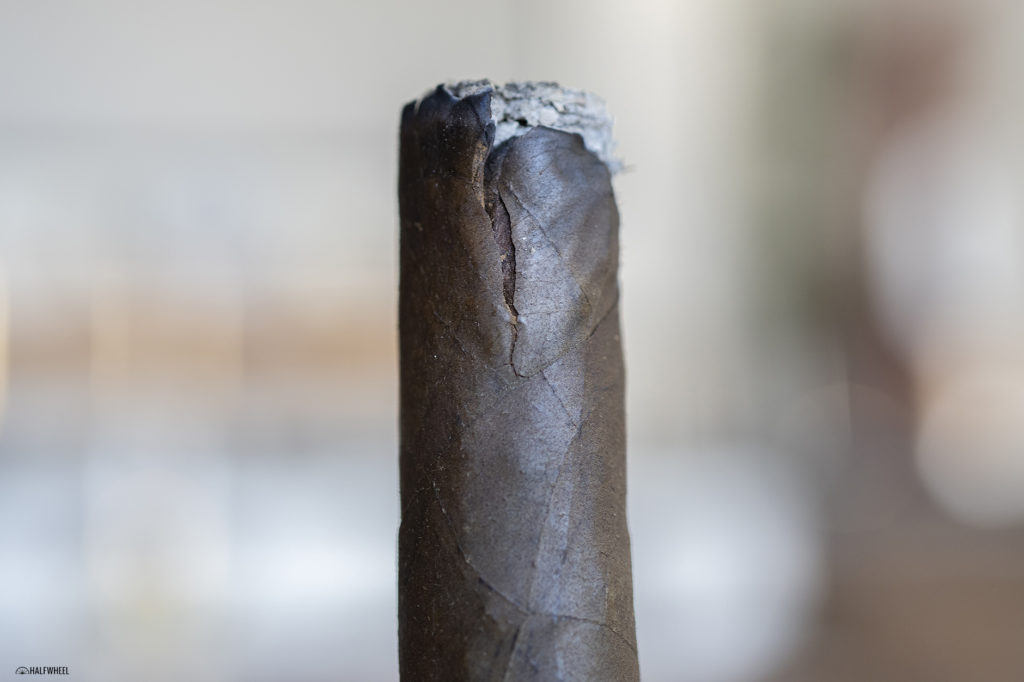
- The first two samples I smoked had significant cracks, including cracking through the binder. I’m not sure what to make of the cause of it—certainly colder temperatures and drier air aren’t helping—but this was one of the weirder instances of a cigar cracking as I could hear the cigar making noises.

- Not only that, but the wrapper dislodged itself from the ash to the point where there was visible separation from the gray ash and the brown and black wrapper.

- African Cameroon is one of the more delicate wrappers used for cigars. I have found that it tends to crack when smoked in drier air. This was one of a number of new cigars using Cameroon wrapper that debuted in the drier, winter months. If I was running a cigar company, there would not be new cigars with Cameroon wrappers released in the winter months.
- Putting someone’s face on a band is not a common feature. The Montecristo Compay 95 Aniversario Salomones II, one of the greatest cigars I’ve ever smoked, had a picture of its namesake’s face on it. It was named for Máximo Francisco Repilado Muñoz, the Cuban singer and guitarist better known as Compay Segundo.
- General Cigar Co./Forged Cigar Co. advertises on halfwheel.
- Cigars for this review were purchased by halfwheel.
- Final smoking time varied between two hours and 20 minutes to two hours and 45 minutes.
- Site sponsors Famous Smoke Shop and STOGIES World Class Cigars carry the Partagas Decadas 2021.
After smoking the first Partagas Decadas 2021, I was dreading having to smoke the next two cigars. The first cigar was a mess: constant relights, a wrapper that was falling apart and a cigar that made noises. Fortunately, the next two cigars were much better. But even at its best the Decadas 2021 isn't as good as many of the Cameroon-wrapped cigars from General Cigar Co., let alone the larger market. I am curious to smoke this cigar in a few months when the air is a bit warmer to see if things taste different, but more importantly, I'm curious to see what else comes of Cameroon-seed tobacco grown in Brazil.


